Related Research Articles
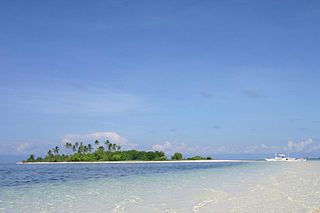
Maritime Southeast Asia comprises the countries of Brunei, East Timor, Indonesia, Malaysia, the Philippines and Singapore. Maritime Southeast Asia is sometimes also referred to as Island Southeast Asia, Insular Southeast Asia or Oceanic Southeast Asia. The 16th-century term "East Indies" and the later 19th-century term "Malay Archipelago" are also used to refer to Maritime Southeast Asia.

The snap matchlock is a type of matchlock mechanism used to ignite early firearms. It was used in Europe from about 1475 to 1640, and in Japan from 1543 until about 1880, and was also largely used by Korea (Joseon) during the Imjin war to the early 20th century.
Peter Nicholas Tarling was a historian, academic, and author. He specialised in Southeast Asian history, and wrote on 18th- and 19th-century Malaysia, North Borneo, Philippines, and Laos, especially regarding foreign involvement in those countries.

Alaungsithu or Sithu I was king of Pagan Dynasty of Burma (Myanmar) from 1112/13 to 1167. Sithu's reign was a prosperous one in which Pagan was an integral part of in-land and maritime trading networks. Sithu engaged in a massive building campaign throughout the kingdom, which included colonies, forts and outposts at strategic locations to strengthen the frontiers, ordination halls and pagodas for the support of religion, as well as reservoirs, dams and other land improvements to assist the farmers. He also introduced standardized weights and measures throughout the country to assist administration as well as trade. He presided over the beginning of a transition away from the Mon culture toward the expression of a distinctive Burman style.
The Cambridge History of China is a series of books published by the Cambridge University Press (CUP) covering the history of China from the founding of the Qin dynasty in 221 BC to 1982 AD. The series was conceived by British historian Denis C. Twitchett and American historian John K. Fairbank in the late 1960s, and publication began in 1978. The complete History will contain 15 volumes made up of 17 books with volumes 5 and 9 consisting of two books each.

Narapati Sithu was king of Pagan dynasty of Burma (Myanmar) from 1174 to 1211. He is considered the last important king of Pagan. His peaceful and prosperous reign gave rise to Burmese culture which finally emerged from the shadows of Mon and Pyu cultures. The Burman leadership of the kingdom was now unquestioned. The Pagan Empire reached its peak during his reign, and would decline gradually after his death.
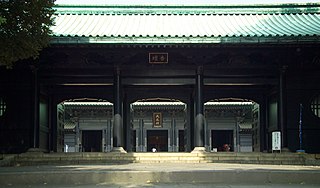
Hayashi Hōkō, also known as Hayashi Nobutatsu, was a Japanese Neo-Confucian scholar, teacher and administrator in the system of higher education maintained by the Tokugawa bakufu during the Edo period. He was a member of the Hayashi clan of Confucian scholars.

Htilominlo was king of Pagan dynasty of Burma (Myanmar) from 1211 to 1235. His 24-year reign marked the beginning of the gradual decline of Pagan dynasty. It was the first to see the impact of over a century of continuous growth of tax-free religious wealth, which had greatly reduced the potential tax base. Htilominlo was the last of the temple builders although most of his temples were in remote lands not in the Pagan region, reflecting the deteriorating state of royal treasury.

Kyaswa was king of Pagan dynasty of Burma (Myanmar) from 1235 to 1251. Kyaswa succeeded his father Htilominlo and was even more devout. Kyaswa's reign like his father's was largely peaceful but the depletion of the royal treasury due to large tax-free religious landholdings became more pronounced. The royal treasury was so depleted that Kyaswa had trouble completing a temple. The empire founded by Anawrahta over two centuries earlier was still peaceful but already on its last legs, unprepared for the internal disorders and external forces that were to come.

Timothy James Brook is a Canadian historian, sinologist, and writer specializing in the study of China (sinology). He holds the Republic of China Chair, Department of History, University of British Columbia.
David George Marr is an American/Australian historian specializing in the modern history of Vietnam.
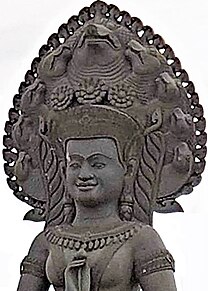
Soma was the ruler of the Kingdom of Funan and widely claimed as the first monarch of Cambodia. She was also the first female leader of Cambodia. She was the consort of Kaundinya I. She is known as Soma (Indian), Liǔyè (Chinese), Liễu Diệp (Vietnamese) and Neang Neak (Khmer).
Margaret Stefana Drower MBE (1911–2012) was a historian of Ancient Near Eastern History and Egyptology. She was awarded the MBE and elected a Fellow of the Society of Antiquaries of London. She wrote the definitive biography of Flinders Petrie.
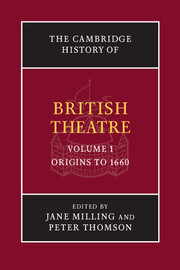
The Cambridge History of British Theatre is a non-fiction work consisting of three volumes in book form. It was originally published in 2004 by Cambridge University Press. It was later published online in 2008, also by Cambridge University Press. It is not an encyclopedia. Essay articles are in rough chronological order and have been compiled in the three volumes by various editors.

Ghurab or gurab is a type of merchant and warship from Nusantara archipelago. The ship was a result of Mediterranean influences in the region, particularly introduced by the Arabs, Persians, and Ottomans. For their war fleet, the Malays prefer to use shallow draught, oared longships similar to the galley, such as lancaran, ghurab, and ghali. This is very different from the Javanese who prefer long-range, deep draught round ships such as jong and malangbang. The reason for this difference is because the Malays operated their ships in riverine water, sheltered straits zone, and archipelagic environment, while the Javanese are often active in the open and high sea.

Istinggar is a type of matchlock firearm built by the various ethnic groups of the Malay Archipelago. The firearm is a result of Portuguese influence on local weaponry, particularly after the capture of Malacca (1511). Before this type of gun, in the archipelago already existed primitive long gun called bedil, or Java arquebus as the Chinese call it. Most of the specimens in the Malay Peninsula are actually Indonesian in origin, manufactured in the Minangkabau lands of West Sumatra. The states of the Malay Peninsula imported this firearm as it was widely used in their wars.

Bedil is a term from Maritime Southeast Asia which refers to various type of firearms and gunpowder weapon, from small pistol to large siege guns. The term bedil comes from wedil and wediluppu in the Tamil language. In its original form, these words refer to gunpowder blast and saltpeter, respectively. But after being absorbed into bedil in the Malay language, and in a number of other cultures in the archipelago, that Tamil vocabulary is used to refer to all types of weapons that use gunpowder. The term bedil and bedhil is known in Javanese and Balinese, in Sundanese the term is bedil, in Batak it is known as bodil, in Makasarese, badili, in Buginese, balili, in Dayak language, badil, in Tagalog, baril, in Bisayan, bádil, in Bikol languages, badil, and in Malay it is badel or bedil. Southeast Asian sources also refer to Pole guns.
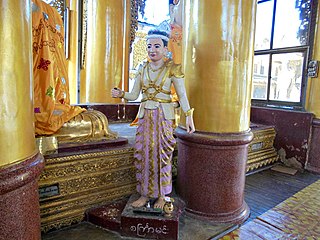
Maha Thiha Thura Dhammaraja, commonly known as Setkya Min or the Prince of Nyaungyan, was an heir apparent of Burma and son of King Bagyidaw and his consort Hsinbyume. He is worshipped as a weizza along with Bo Bo Aung.

Early New High German literature refers to literature written in German between the middle of the 14th century and the middle of the 17th. The term Early Modern German literature is also used to cover all or part of the same period.
References
- ↑ Tarling, Nicholas, ed. (1993). The Cambridge History of Southeast Asia. Vol. 1. Cambridge University Press. doi:10.1017/CHOL9780521355056. ISBN 9781139055475.
- ↑ Tarling, Nicholas, ed. (1993). The Cambridge History of Southeast Asia. Vol. 2. Cambridge University Press. doi:10.1017/CHOL9780521355063. ISBN 9781139055482.